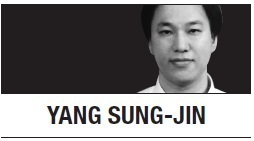[Digital Simplicity] A nation of portal journalism, ruled by the indomitable duopoly
By Yang Sung-jinPublished : May 22, 2021 - 16:00

South Korea is a nation of portal journalism -- for better or worse. The two biggest portals, Naver and Kakao, form an insurmountable duopoly, holding a firm grip on almost every digital sector, ranging from search to online shopping to digital news. Both are running massive news platforms, drawing most eyeballs away from individual media sites.
Believe it or not, Naver and Kakao claim that they are not media outlets. However, it remains a fact that their influence as something close to media is tangible and powerful enough to overwhelm and outsmart established media outlets.
The reality is that the majority of local media are just news content providers for the duopoly, meekly following their news guidelines and frantically trying to boost their traffic on portal platforms rather than their own websites.
The solidifying of such business relations has two underlying reasons. First, Naver and Kakao offer a comprehensive pool of news free-of-charge, fed by dozens of major news media as well as hundreds of smaller online news outlets. For readers, browsing the news on a single platform is far faster and more convenient than making rounds on several media sites. For news outlets, the exposure of their news articles on portals has more impact than on their sites.
Second, the two portals pay fees to news content providers, a crucial source of income that newspapers and broadcasters cannot ignore at a time when the ad revenue and readership for their legacy platforms are shrinking at a steady pace.
It was in 2000 when Korean news media started providing news to then fledgling portals. A turning point came in 2009 when Apple’s 3GS iPhone made a historic debut in Korea, disrupting not only the handset market but also digital media sector. Since then, Korean newspapers and broadcast stations have steadily lost their influence to the portals, with newspaper readers and TV viewers opting for a comprehensive news curation on portals.
Naver’s news service handles about 60,000 news articles per day: 36,000 from 69 official media partners, whose news is regularly featured on the news section, and 24,000 from affiliate partners, whose content is available only through search queries by users.
One estimate puts the total page views of Naver per day at 300 million and the page views generated by news at about 100 million.
The vast scope of news and the resulting online traffic volume on Naver and Kakao, plus the rapid upgrades of news section interfaces and functionalities by a large number of programmers, mean that there is a slim, if not zero, chance for individual media to be successful outside of the portal platforms.
But the sheer dominance of the duopoly in the digital media sector has led to a barrage of criticism. To boost traffic on portals, some media companies resorted to what is called “abusing,” referring to the practice of generating a number of cookie-cutter stories and gossipy articles with click-bait headlines. The handpicked curation of top and major news on Naver and Kakao news sections was also under constant attack for alleged political bias.
To avoid disputes about fairness and neutrality, both portals have been tinkering with news curation and content payment policies. For instance, Naver decided to switch to AI-recommended news display system on its front page and news section in April 2019.
Naver’s latest move is a tweak to the news quality guideline closely connected with its profit-sharing scheme with media partners. According to a revised guideline, it pays less to media partners generating “NG factor” stories, such as gossipy news or articles originating from another news source. At the same time, the portal pays more to partners producing “good factor” stories, considering a set of elements such as how long visitors spend time reading the particular article.
Naver’s move is aimed at helping improve the quality of portal journalism, but it remains to be seen whether the embattled media outlets here can avoid succumbing to the temptation of easy traffic with copycat stories.
By Yang Sung-jin (insight@heraldcorp.com)
Yang Sung-jin is the multimedia editor of The Korea Herald. -- Ed.







![[KH Explains] Hyundai's full hybrid edge to pay off amid slow transition to pure EVs](http://res.heraldm.com/phpwas/restmb_idxmake.php?idx=644&simg=/content/image/2024/04/18/20240418050645_0.jpg&u=20240419100350)







![[From the Scene] Monks, Buddhists hail return of remains of Buddhas](http://res.heraldm.com/phpwas/restmb_idxmake.php?idx=652&simg=/content/image/2024/04/19/20240419050617_0.jpg&u=20240419175937)

![[KH Explains] Hyundai's full hybrid edge to pay off amid slow transition to pure EVs](http://res.heraldm.com/phpwas/restmb_idxmake.php?idx=652&simg=/content/image/2024/04/18/20240418050645_0.jpg&u=20240419100350)

![[Today’s K-pop] Illit drops debut single remix](http://res.heraldm.com/phpwas/restmb_idxmake.php?idx=642&simg=/content/image/2024/04/19/20240419050612_0.jpg&u=)